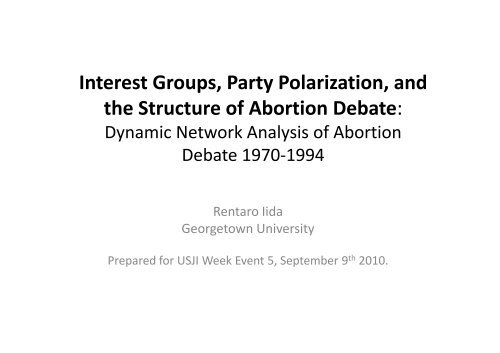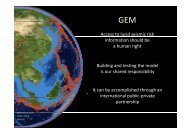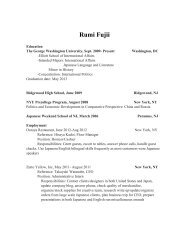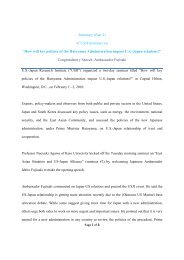Mr. Rentaro Iida, Ph.D Candidate, Georgetown University
Mr. Rentaro Iida, Ph.D Candidate, Georgetown University
Mr. Rentaro Iida, Ph.D Candidate, Georgetown University
Create successful ePaper yourself
Turn your PDF publications into a flip-book with our unique Google optimized e-Paper software.
Interest Groups, Party Polarization, and<br />
the Structure of Abortion Debate:<br />
Dynamic Network Analysis of Abortion<br />
Debate 1970-1994<br />
<strong>Rentaro</strong> <strong>Iida</strong><br />
<strong>Georgetown</strong> <strong>University</strong><br />
Prepared for USJI Week Event 5, September 9 th 2010.
A question of party realignment and<br />
interest groups<br />
• How do parties change their issue positions?<br />
– My argument: “A small set of single issue groups and<br />
ideas they advocated had impacts on how parties<br />
stand on a issue.”<br />
– Case: Over the past three decades, the Republican<br />
party and Democrat party have become increasingly<br />
divided on the abortion issue.<br />
– Theory & method: “Networks”
Why should we care?<br />
• Arguments about a few political elites including<br />
interest groups with ideological motives, that<br />
doesn’t necessarily have direct ties to mass public,<br />
have become overrepresented in the US politics<br />
(cf. Skocpol 2004).<br />
• They may be undermining representative<br />
democracy by skipping party (electoral) process,<br />
causing American politics to be polarized. (cf.<br />
Fiorina et al. 2005, Crenson and Ginsberg 2002)
What is a party? How should we understand interactions<br />
between interest groups and political parties?<br />
• Existing Theories<br />
– Coalitions of politicians who is seeking office, and the<br />
institutions which makes the coordination easy (cf.<br />
Aldrich 1995).<br />
– Parties as coalitions of interest groups (Cohen et al.<br />
2008; Bawn et al. 2007)<br />
– Parties as networks (Masket et al. 2009, Koger et al.<br />
2009)<br />
• However, a very few empirical works on party<br />
realignments conceptualizing parties as networks.
Challenges on data<br />
• Data on interest group activities are extremely<br />
hard to collect in general.<br />
• Conventional empirical strategies<br />
– Uses of various surveys and/or congressional roll calls<br />
• There are very few data on party activities<br />
involving diverse set of actors.<br />
• The conventional empirical strategies tend to<br />
require scholars to focus on one set of actors at a<br />
time.
Which set of actors moved first?
Alternatives: Network Analysis &<br />
Theory<br />
• Many interesting changes in party politics do not start<br />
with what’s changing within one set of actors, but<br />
what’s happening between different types of actors.<br />
• Party is a network among diverse set of actors.<br />
– Theory: Therefore, “what parties stand for” develops<br />
through intentional “brokering” efforts between interest<br />
groups and public figures like Presidents and legislators.<br />
• Network analysis: a tool to visualize and quantify such<br />
structures.<br />
– Treating the abortion debate as a dynamic network.
Data construction<br />
• Using content analysis data gathered by Ferree, Gamson, Gerhard, and Rucht<br />
(2002) on the development of abortion discourse from 1962 to 1994, I was able to<br />
build such network data. They have looked sample of New York Times and LA<br />
Times identified eight “frames” as well as 315 subsets of idea-elements, such as<br />
“abortion is murder” and “women have a right to self-defense” spoken by over<br />
2000 different political actors including journalists, interest groups, politicians<br />
nested in 128 different organization.
What should we expect from the data?<br />
• We should see more networking activities (i.e.<br />
idea sharing activities) over time.<br />
• We should see more networking activities across<br />
different types of actors over time.<br />
• Interest groups of both side should first become<br />
central in the discourse network.<br />
• Politicians other actor should become central in<br />
the networks later.<br />
• We should see more meaningful clusters of actors<br />
developing over time.
speaker network 1970-75<br />
speaker network 1989-94
Count of Ties at Individual Speaker Level (1970-1994)
Count of ties at organizational category level (1970-1994)
Eigenvector Centrality<br />
• A measure about how much a particular node<br />
is connected to well-connected nodes.<br />
– Applications for webpages, congressional speech<br />
etc.<br />
– Tells you about how much control you have for the<br />
network.
Community detections, and<br />
modularity<br />
Identify which actors tend to<br />
share idea-together and group<br />
them into “communities”.<br />
Modularity = (number of ties<br />
within community)- (expected<br />
value of such ties)<br />
e.g. An application in measuring<br />
polarizations in Congress.
Conclusions<br />
• We should theorize party realignment as evolutions of<br />
networks containing diverse set of actors.<br />
• In the case of abortion, interest groups seemed to had a<br />
first-mover advantage in shaping what will be discussed in<br />
media, the politicians and groups with broader focus later<br />
adopted the same kind of language to discuss the abortion.<br />
• In order for an issue to become an salient party cleavage, a<br />
single issue groups has to involve diverse set of people.<br />
Interest<br />
groups?<br />
Polarization of<br />
Media discourse











